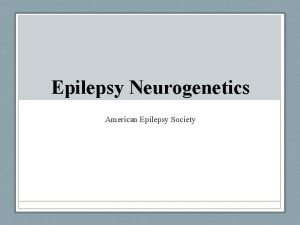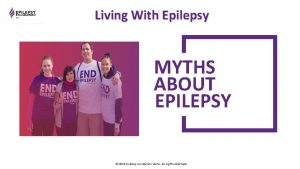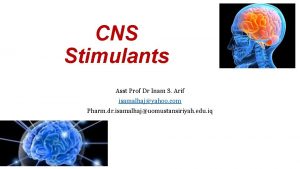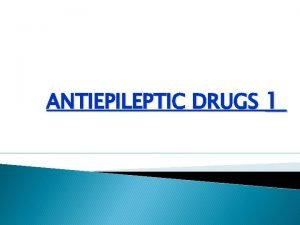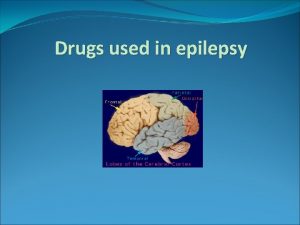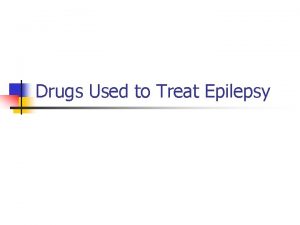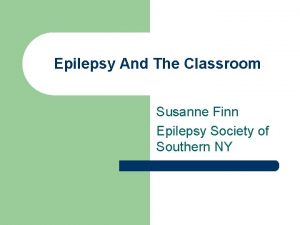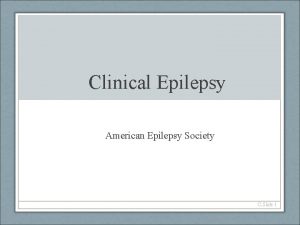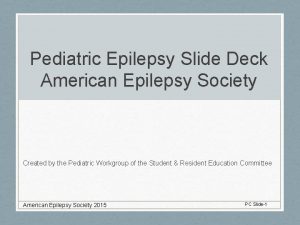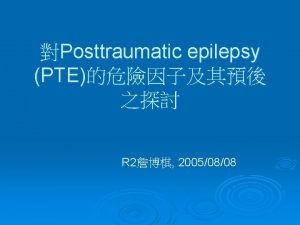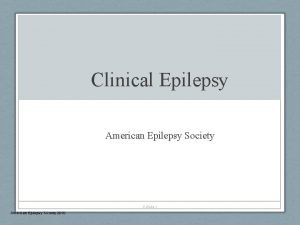Drugs for Epilepsy Asst Prof Dr Inam S


































- Slides: 34

Drugs for Epilepsy Asst Prof Dr Inam S. Arif isamalhaj@yahoo. com Pharm. dr. isamalhaj@uomustansiriyah. edu. iq

v. Epilepsy is: üThe third most common neurologic disorder after cerebrovascular and Alzheimer’s disease üA collection of different seizure types and syndromes originating from several mechanisms üIt is a sudden, excessive, and synchronous discharge of cerebral neurons, which may result in a variety of events, including loss of consciousness, abnormal movements, atypical or odd behavior, and distorted perceptions that are of limited duration but recur if untreated v. The site of origin of the abnormal neuronal firing determines the symptoms that are produced.

Overview (cont. ) • if the motor cortex is involved, the patient may experience abnormal movements or a generalized convulsion. • Seizures originating in the parietal or occipital lobe may include visual, auditory, and olfactory hallucinations • In general, seizures can be controlled with one medication in approximately 75% of patients • Patients may require more than one medication in order to optimize seizure control, and some patients may never obtain total seizure control

Etiology of Seizure üIn most cases, epilepsy has no identifiable cause üFocal areas , may be triggered into activity by changes in physiologic factors, e. g. alteration in blood gases, p. H, electrolytes, and blood glucose and changes in environmental factors, such as sleep deprivation, alcohol intake, and stress üPrimary focus üEpilepsy can be due to genetic, structural, or metabolic cause or an unknown cause

Etiology (cont. ) A. Genetic epilepsy These seizures result from an inherited abnormality in the central nervous system (CNS) B. Structural/metabolic epilepsy A number of causes, e. g. illicit drug use, tumor, head injury, hypoglycemia, meningeal infection, and the rapid withdrawal of alcohol from an alcoholic, can precipitate seizures C. Unknown cause When no specific anatomic cause for the seizure, e. g. trauma or neoplasm, is evident

Classification of Seizures • Seizures have been categorized by site of origin, etiology, electrophysiologic correlation, and clinical presentation

Classification of Seizures (cont. ) A. Focal üFocal seizures involve only a portion of the brain/one lobe of one hemisphere. üThe symptoms of each seizure type depend on the site of neuronal discharge and on the extent to which the electrical activity spreads to other neurons in the brain. ü Focal seizures may progress to become generalized tonic–clonic seizures.

Classification of Seizures (cont. ) 1. Simple partial: ü Electrical discharge does not spread, & no loss of consciousness or awareness. üThe patient shows abnormal activity of a single limb or muscle group that is controlled by the region of the brain experiencing the disturbance. 2. Complex partial: üComplex sensory hallucinations and mental distortion ü Motor dysfunction may involve chewing movements, diarrhea, and/or urination, üConsciousness is altered üMay spread to become generalized convulsion.

Classification of Seizures (cont. ) B. Generalized ümay begin locally and then progress to include abnormal electrical discharges throughout both hemispheres of the brain. üPrimary generalized seizures may be convulsive or nonconvulsive, and the patient usually has an immediate loss of consciousness 1. Tonic–clonic: Loss of consciousness, followed by tonic (continuous contraction) & clonic (rapid contraction and relaxation) phases. ü The seizure may be followed by a period of confusion due to the depletion of glucose and energy stores.

Classification of Seizures (cont. ) 2. Absence: übrief, abrupt, & self- limiting loss of consciousness ü Starts at 3 to 5 years of age and lasts until puberty or beyond. üThe patient stares and exhibits rapid eye-blinking, for 3 to 5 seconds ü An absence seizure has a very distinct 3/sec spike and wave discharge seen EEG 3. Myoclonic: üconsist of short episodes of muscle contractions that may recur for several minutes ügenerally occur after wakening and exhibit as brief jerks of the limbs üoccur at any age but usually begin around puberty or early adulthood. 4. Clonic: üshort episodes of M contractions resemble myoclonic seizures. üConsciousness is more impaired with clonic seizures as compared to myoclonic. 5. Tonic: involve increased tone in the extension muscles & <60 seconds long. 6. Atonic: known as drop attacks &characterized by a sudden loss of muscle tone.


Antiepilepsy medication Benzodiazepines • GABA inhibitory receptors to reduce firing rate • reserved for emergency or acute sei- zure treatment due to tolerance • Clonazepam & Clobazam adjunctive therapy for particular types of seizures • Diazepam/ rectal/ avoid or interrupt prolonged generalized tonic– clonic seizures or clusters when oral administration is not possible

Carbamazepine • Blocks Na channels • Effective in focal seizures & generalized tonic–clonic seizures, trigeminal neuralgia, and bipolar disorder • Absorbed slowly & incomplete after oral administration • Induces its own metabolism, resulting in lower total carbamazepine blood concentrations at higher doses • inducer of the CYP 1 A 2, CYP 2 C, and CYP 3 A anglucuronosyltransferase (UGT) enzymes, which increases the clearance of other drugs • Hyponatremia /elderly • Carbamazepine CI in absence seizures because it may cause an increase in seizures.

Eslicarbazepine • A prodrug that is converted to the active metabolite eslicarbazepine by hydrolysis • S-licarbazepine is the active metabolite of oxcarbazepine • Block voltage-gated Na channel & used for partial-onset seizures in adults • Linear pharmacokinetics and is eliminated via glucuronidation • SE: dizziness, somnolence, diplopia, and headache, rash, psychiatric side effects, and hyponatremia occur rarely.

Ethosuximide • Rreduces propagation of abnormal electrical activity in the brain, most likely by inhibiting T-type calcium channels • It is only effective in treating absence seizures.

Ezogabine • Open voltage-gated M-type K channels leading to stabilization of the resting membrane potential • Exhibits linear pharmacokinetics and no drug interactions at lower doses • SE: urinary retention, QT interval prolongation, blue skin discoloration, and retinal abnormalities

Felbamate ühas a broad spectrum of anticonvulsant action with multiple proposed mechanisms üBlock voltage-dependent Na channels üCompeting with the glycine coagonist binding site on the N-methyl-Daspartate (NMDA) glutamate receptor ü Block calcium channels, and potentiating GABA action ü It is an inhibitor of drugs metabolized by CYP 2 C 19 and induces drugs metabolized by CYP 3 A 4 üReserved for use in refractory epilepsies (particularly Lennox-Gastaut syndrome) because of the risk of aplastic anemia (about 1: 4000) and hepatic failure.

Gabapentin • Analog of GABA/ enhance GABA actions or convert to GABA • Precise mechanism of action is not known • Approved as adjunct therapy for focal seizures and treatment of postherpetic neuralgia • Nonlinear pharmacokinetics due to its uptake by a saturable transport system from the gut • Does not bind to plasma proteins & excreted unchanged by the kidneys. • Well tolerated by the elderly population with partial seizures due to its relatively mild adverse effects • It may also be a good choice for the older patient because there are few drug interactions.

Lacosamide • Affects voltage-gated Na channels / stabilization of hyperexcitable neuronal membranes and inhibition of repetitive neuronal firing • Binds to collapsin response mediator protein-2 (CRMP-2), a phosphoprotein involved in neuronal differentiation and control of axonal out- growth • The role of CRMP-2 binding in seizure control is unknown • Approved for adjunctive treatment of focal seizures • SE: dizziness, headache, and fatigue

Lamotrigine • Blocks Na channels & high voltage-dependent Ca channels • Effective in a wide variety of seizure types, including focal, generalized, absence seizures, & bipolar disorder • Metabolized primarily to the 2 -N-glucuronide metabolite through the UGT 1 A 4 pathway • General inducers increase clearance leading to lower concentrations, whereas divalproex results in a significant decrease in lamotrigine clearance (higher lamotrigine concentrations • Slow titration is necessary due to risk of rash, which may progress to a serious, life-threatening reaction.

Levetiracetam • Approved for adjunct therapy of focal onset, myoclonic & primary generalized tonic–clonic seizures in adults and children • Mechanism of anticonvulsant action is unknown • high affinity for a synaptic vesicle protein (SV 2 A) • Well absorbed orally and excreted in urine mostly unchanged, resulting in few to no drug interactions • Cause mood alterations that may require a dose reduction or a change of medication.

Oxcarbazepine • A prodrug, rapidly reduced to the 10 -monohydroxy (MHD) metabolite responsible for its anticonvulsant activity • MHD blocks N channels, preventing the spread of the abnormal discharge • modulate calcium channels/adults and children with partial-onset seizures • less potent inducer of CYP 3 A 4 and UGT than carbamazepine • SE: hyponatremia limits use in the elderly.

Perampanel • Selective α-amino-3 -hydroxy-5 - methyl-4 -isoxazolepropionic acid antagonist resulting in reduced excitatory activity • Perampanel has a long half-life enabling once-daily dosing / adjunctive treatment of partial-onset seizures in patients 12 years or older • Perampanel is a newer antiepileptic agent

Phenobarbital and primidone • Enhancement of the inhibitory effects of GABA-mediated neurons • Metabolized to phenobarbital (major) and phenylethylmalonamide • both with anticonvulsant activity • Phenobarbital is used primarily in the treatment of status epilepticus when other agents fail.

Phenytoin and fosphenytoin • Blocks voltage-gated Na channels • Effective in focal and generalized tonic– clonic seizures & status epilepticus • Induces drugs metabolized by the CYP 2 C and CYP 3 A families and the UGT enzyme system • Exhibits saturable enzyme metabolism resulting in nonlinear pharmacokinetic properties • Depression of the CNS occurs particularly in the cerebellum & vestibular system/nystagmus and ataxia/ elderly

• Gingival hyperplasia may cause the gums to grow over the teeth • Long-term use may lead to development of peripheral neuropathies and osteoporosis/serious toxicity and adverse effects. • Fosphenytoin a prodrug, rapidly converted to phenytoin in the blood within minutes/IM • drug of choice and standard of care for IV and IM

Pregabalin • Binds to the α 2 -δ site, an auxiliary subunit of voltage-gated Ca channels in the CNS, inhibiting excitatory neurotransmitter release. • Used in focal seizures, diabetic peripheral neuropathy, postherpetic neuralgia, and fibromyalgia • More than 90% of pregabalin is eliminated by kidneys • Weight gain and peripheral edema have been reported. • When the hepatic hydroxylation system becomes saturated, small increases in the dose of phenytoin cause a large increase in the plasma concentration of the drug.

Rufinamide • Acts at Na channels • approved for the adjunctive treatment of seizures associated with Lennox- Gastaut syndrome in children >4 yrs & adults • A weak inhibitor of CYP 2 E 1 and a weak inducer of CYP 3 A 4 enzymes • Food increases absorption and peak serum concentrations • Serum concentrations affected by other antiepilepsy medications • Induced by carbamazepine and phenytoin and inhibited when given with valproate • SE: potential for shortened QT intervals, patients with familial short QT syndrome should not be treated with rufinamide.

Topiramate • blocks voltage-dependent Na channels, reduces high-voltage Ca currents (L type) • A carbonic anhydrase inhibitor & may act at glutamate (NMDA) sites • Effective in partial and primary generalized epilepsy & also approved for prevention of migraine • inhibits CYP 2 C 19 & induced by phenytoin and carbamazepine • SE: include somnolence, weight loss, and paresthesias, renal stones, glaucoma, oligohidrosis (decreased sweating), & hyperthermia have also been reported.

Valproic acid and divalproex • Na channel blockade, blockade of GABA transaminase & action at the Ttype Ca channels • Effective in focal and primary generalized epilepsies • Divalproex sodium is a combination of Na valproate & valproic acid that is converted to valproate when it reaches the gastrointestinal tract • Commercial products are available in multiple-salt dosage forms and extended-release formulations • Valproate inhibits metabolism of the CYP 2 C 9, UGT, and epoxide hydrolase systems • Rare hepatotoxicity may cause a rise in liver enzymes, which should be monitored frequently • Teratogenicity is also of great concern.

Vigabatrin • Irreversible inhibitor of GABA transaminase (GABA-T)/enhance GABAergic activity • SE: visual field loss ranging from mild to severe in 30% or more of patient.

Zonisamide • Sulfonamide deriv. / broad spectrum of action/ approved for focal epilepsy • Has multiple effects, including blockade of both voltage-gated Na channels and T -type Ca currents • Has a limited amount of carbonic anhydrase activity • Metabolized by the CYP 3 A 4 isozyme and may, to a lesser extent, be affected by CYP 3 A 5 and CYP 2 C 19 • SE: CNS adverse effects, kidney stones & oligohidrosis has been reported • CI in patients with sulfonamide or carbonic anhydrase inhibitor hypersensitivity.

Status Epilepticus • Two or more seizures occur without recovery of full consciousness in between episodes may be focal or primary generalized, convulsive or nonconvulsive • A life threatening, requires emergency treatment • Administration of a fast-acting medication e. g. benzodiazepine, followed by a slower-acting medication such as phenytoin

Women’s Health & Epilepsy • Women of childbearing potential with epilepsy require assessment of their antiepilepsy medications in regard to contraception and pregnancy planning. • Several antiepilepsy medications increase the metabolism of hormonal contraceptives, potentially rendering them ineffective. (phenytoin, phenobarbital, carbamazepine, topiramate, oxcarbazepine, rufinamide, & clobazam) • Pregnancy planning is vital, as many antiepilepsy medications have the potential to affect fetal development and cause birth defects/(1 -5 mg) of folic acid prior to conception • Divalproex and barbiturates should be avoided • The pharmacokinetics of antiepilepsy medications and the frequency and severity of seizures may change during pregnancy. • Regular monitoring by both an obstetrician and a neurologist is important
 Mästare lärling modell
Mästare lärling modell Verksamhetsanalys exempel
Verksamhetsanalys exempel Delegerande ledarskap
Delegerande ledarskap Stål för stötfångarsystem
Stål för stötfångarsystem Cks
Cks Adressändring ideell förening
Adressändring ideell förening Shivaiter
Shivaiter Bo bergman jag fryser om dina händer
Bo bergman jag fryser om dina händer Inköpsprocessen steg för steg
Inköpsprocessen steg för steg Strategi för svensk viltförvaltning
Strategi för svensk viltförvaltning Standardavvikelse formel
Standardavvikelse formel Datorkunskap för nybörjare
Datorkunskap för nybörjare Tack för att ni har lyssnat
Tack för att ni har lyssnat Rutin för avvikelsehantering
Rutin för avvikelsehantering Vad står k.r.å.k.a.n för
Vad står k.r.å.k.a.n för Läkarutlåtande för livränta
Läkarutlåtande för livränta Treserva lathund
Treserva lathund Tack för att ni lyssnade
Tack för att ni lyssnade Påbyggnader för flakfordon
Påbyggnader för flakfordon Egg för emanuel
Egg för emanuel Tobinskatten för och nackdelar
Tobinskatten för och nackdelar Nyckelkompetenser för livslångt lärande
Nyckelkompetenser för livslångt lärande Tack för att ni har lyssnat
Tack för att ni har lyssnat Var finns arvsanlagen
Var finns arvsanlagen Byggprocessen steg för steg
Byggprocessen steg för steg Tidbok
Tidbok Myndigheten för delaktighet
Myndigheten för delaktighet Presentera för publik crossboss
Presentera för publik crossboss Rådet för byggkompetens
Rådet för byggkompetens Kontinuitetshantering
Kontinuitetshantering Kung som dog 1611
Kung som dog 1611 Tack för att ni har lyssnat
Tack för att ni har lyssnat Boverket ka
Boverket ka Mall för referat
Mall för referat Varför kallas perioden 1918-1939 för mellankrigstiden?
Varför kallas perioden 1918-1939 för mellankrigstiden?





































